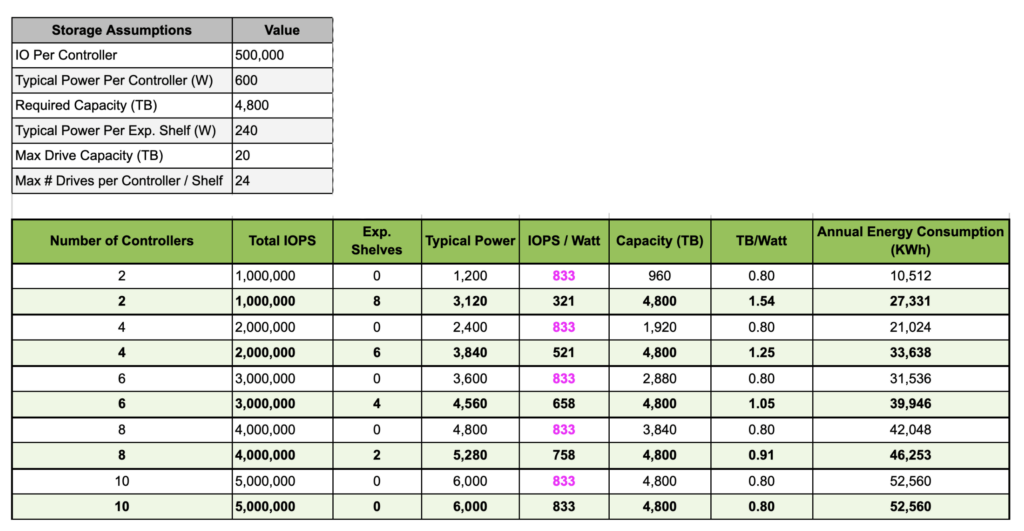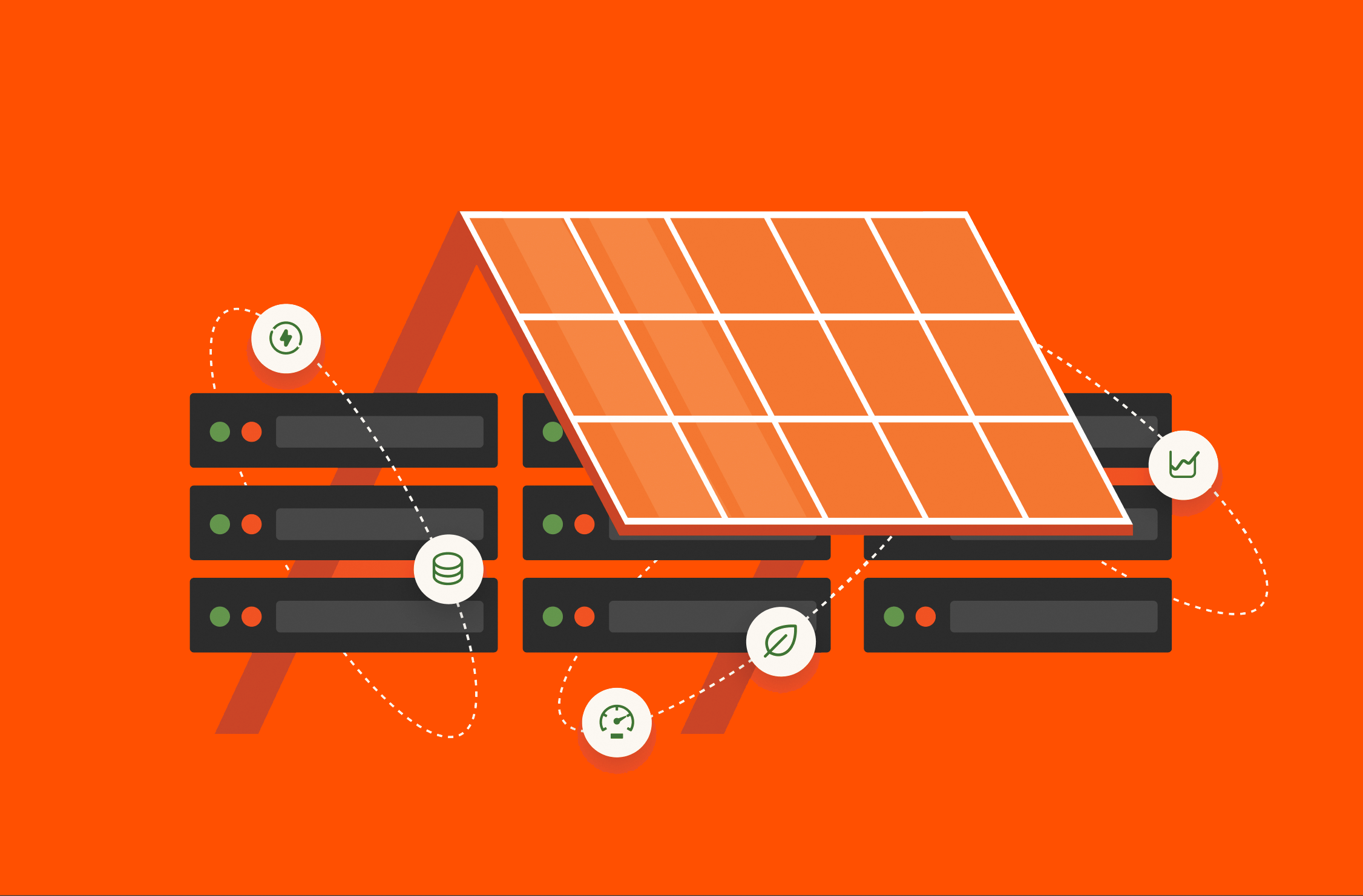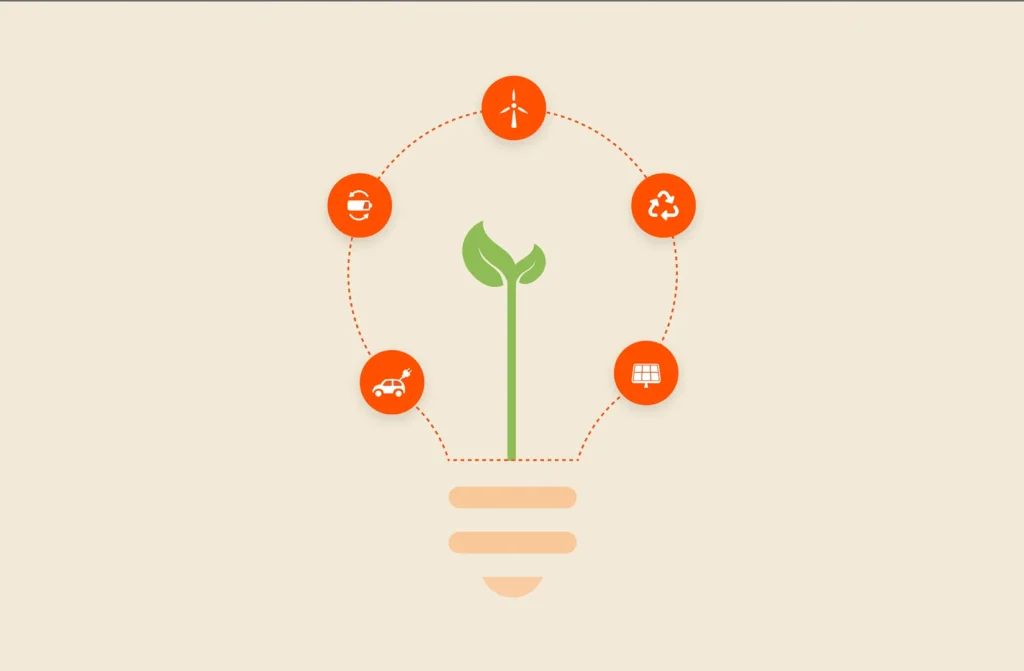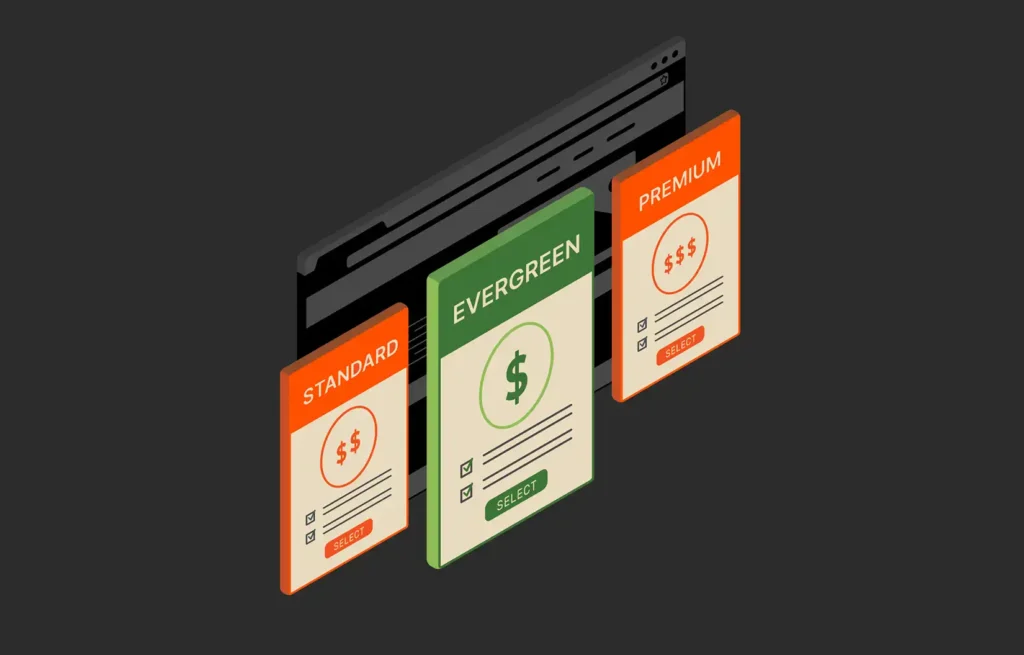요약
While a storage system may appear to be an energy-efficient solution in a benchmark, the actual performance may differ when it’s scaled to meet the specific needs of a business. A more comprehensive approach that looks at right-sizing the solution for performance, energy efficiency, space optimization, and long-term reliability is needed.
엔터프라이즈 스토리지 업계에서 지속가능성은 중요한 고려 사항이 되었지만, 스토리지 제품 간 에너지 효율성을 비교하는 것은 단순한 벤치마크나 인증 테스트 점수보다 훨씬 더 미묘한 차이가 존재합니다. 특정 벤치마크는 가장 에너지 효율적인 시스템을 식별한다고 주장할 수 있지만, 실제로는 이러한 테스트가 실제 에너지 소비에 영향을 미치는 모든 요인을 파악하지 못하는 경우가 많습니다.
단일 지표의 한계
스토리지 시스템은 드라이브 크기, 캐시, 데이터 보호 체계 등 다양한 구성 옵션을 제공하며, 이는 전력과 공간 소비에 직접적인 영향을 미칩니다. 단일 합성 테스트 결과로는 이러한 변수를 완전히 파악할 수 없습니다. 예를 들어, 캐시 크기가 큰 스토리지 어레이를 구성하면 캐시에서 성능을 우선시하는 시스템에 유리하게 결과가 왜곡될 수 있으며, 이러한 전략은 실제 에너지 효율성으로 이어지지 않을 수 있습니다.
이러한 구성의 대부분은 고객의 특수한 요구 사항에 따라 맞춤화됩니다. 더 크거나 더 효율적인 드라이브, 고급 데이터 보호 메커니즘 또는 더 많은 캐싱 기능을 갖춘 스토리지 시스템은 더 작은 드라이브와 최소한의 데이터 보호 기능을 갖춘 스토리지 시스템과 에너지를 다르게 소비합니다. 따라서 에너지 효율을 유의미하게 비교하려면, 고객의 실제 요구 사항을 충족하는 특정 구성을 중심으로 표준화해야 합니다.
주의 사항: 에너지 효율성 지표로 위장한 성능 벤치마크
트랜스 옵티멀 포인트 핫 밴드 워크로드 테스트(TOPHBWT)와 같은 성능 벤치마크 테스트는 특정 기간의 제한된 혼합 워크로드를 기반으로 와트당 IOPS(Input/Output Operations Per Second)를 측정합니다. 이러한 지표는 특정 시나리오에서 최고 효율을 강조할 수 있지만, 각 고객마다 직면할 수 있는 다양한 워크로드 구성과 운영 요구 사항을 고려하지 않습니다. 즉, 특정 요구 사항에 맞게 구성된 스토리지 시스템의 실제 에너지 효율성을 반영하지 않을 수 있으므로 고객은 이러한 결과를 해석할 때 주의해야 합니다.
또한, 성능 벤치마크는 하드 디스크 드라이브(HDD) 기반 시대의 테스트 아티팩트인 테스트 데이터 캐시 허용량에 따라 크게 영향을 받을 수 있다는 점도 유의해야 합니다. 캐시에서 데이터를 검색하면 I/O 속도가 빨라지고 전체 벤치마크 점수가 상승합니다. 하지만 실제로 애플리케이션 데이터는 항상 캐시에 존재하는 것이 아니며, 장기간 동안 저장된 위치인 스토리지 미디어에서 데이터를 검색해야 합니다. 즉, 데이터 검색의 실제 에너지 소비와 성능 영향은 TOPHBWT와 같은 벤치마크에서 완전히 파악할 수 없습니다. 따라서 비용, 구성, 전체 에너지 소비량에 관계없이 매우 높은 ‘최고’ IOPS 수치로 확장할 수 있는 시스템이 그렇지 않은 시스템보다 에너지 효율이 더 높은 것처럼 보일 수 있습니다. 하지만 ‘최고 IOPS = 최고 에너지 효율’이라는 접근 방식을 받아들이기 전에 조금 더 자세히 살펴봅시다.
다음은 컨트롤러 수 및/또는 확장 쉘프 수를 확장하여 성능과 용량을 확장할 수 있는 데이터센터 스토리지 솔루션을 보여주는 간단한 예시입니다:

표 1: 용량 요구 사항 충족을 위해 어레이 컨트롤러 또는 확장 쉘프 추가 시 연간 에너지 소비량.
표 1은 확장 쉘프가 없다고 가정할 때, 컨트롤러가 2개에서 10개인 어레이 구성에서 와트당 IOPS가 어떻게 일정하게 유지되는지 보여줍니다. 그러나 연간 에너지 소비량은 크게 달라집니다. 8개의 확장 쉘프가 있는 컨트롤러 2개 솔루션과 확장 쉘프가 없는 컨트롤러 10개 솔루션을 해당 와트당 IOPS 값을 사용하여 비교하면, 10개의 컨트롤러 구성이 거의 두 배의 에너지를 사용하지만 가장 에너지 효율적이라는 것을 알 수 있습니다! 꽤 흥미로운 결과입니다.
이 예에서 요구되는 스토리지 용량인 4.8 페타바이트(PB)는 컨트롤러 10개인 시스템을 제외한 모든 시스템에서 단지 컨트롤러 인클로저에만 담을 수 있는 용량을 초과합니다. (표 1의 다른 예시들에서는 적어도 일부 확장 쉘프가 필요합니다.) 각 컨트롤러 수에 대한 표 1의 두 번째 항목은 용량 요구 사항을 충족하기 위해 확장 쉘프만 사용할 때의 결과를 보여줍니다. 용량과 함께 컨트롤러의 수를 확장하는 스토리지 시스템에서는 확장 쉘프가 적거나 전혀 없는 구성에서 와트당 IOPS 값이 가장 높습니다. 확장 쉘프 자체가 두 개의 추가 컨트롤러 전력의 25% 미만을 소비하긴 하지만, 와트당 IOPS 지표에 부정적인 영향을 미칩니다. 이 때문에 공급업체는 추가 IOPS가 필요하지 않더라도 가장 높은 와트당 IOPS 값을 달성하기 위해 확장 쉘프가 아닌 컨트롤러를 추가하여 용량을 확장할 수 있습니다. 이는 불필요하게 비용과 에너지 소비를 증가시키며, 솔루션의 총 에너지 소비가 중요하지 않다고 가정합니다. 그러나 실제로 에너지 소비는 중요하며, 용량을 확장할 때 컨트롤러를 추가해야 하는 요구 사항은 고객이 필요 이상으로 에너지 비효율적인 솔루션을 구매하게 할 수 있습니다.
이것이 바로 퓨어스토리지가 고객에게 보다 포괄적이고 투명한 스토리지 솔루션 평가 접근 방식을 제공하는 이유입니다. 이 방식은 먼저 워크로드 특성과 최대 성능 요구 사항을 설정한 후 다양한 솔루션 옵션에 대한 에너지와 스토리지 효율성을 평가합니다.
올바른 스토리지 솔루션 선택 시 고려 사항
대부분의 엔터프라이즈 스토리지 구매에서 고객은 성능, 용량, 에너지 소비, 비용, 사용 용이성 등 여러 지표 간의 균형을 고려합니다. 퓨어스토리지는 기업들이 스토리지 솔루션을 평가할 때 간단하고 투명한 지표를 사용해야 한다고 믿습니다. 와트당 스토리지 용량(TB/와트), 랙 단위당 스토리지 밀도(TB/RU), 최대 처리 대역폭당 와트(와트/GB 출력), 유효 용량당 비용 등의 지표를 사용하면 각 구성 요소가 성능, 확장성 및 총 소유 비용(TCO) 목표를 충족하는지 확인할 수 있습니다. 효율성 비교가 얼마나 명확해지는지에 대한 예는 표 1의 와트당 TB 열에서 확인할 수 있습니다. 연간 에너지를 가장 적게 사용하고 성능 및 용량 요구 사항을 충족하는 구성이 가장 높은 가치를 가집니다. 퓨어스토리지는 플래시를 디스크처럼 사용하는 것이 아니라 플래시처럼 사용하는 방식으로 설계된 시스템이 항상 에너지 소비와 랙 공간 활용 측면에서 더 효율적일 것이라고 확신합니다.
퓨어스토리지의 에너지 및 공간 효율성 이점의 핵심은 플래시를 플래시로 관리하고, 현재 가장 큰 상용 SSD보다 용량은 최대 5배 크지만 전력 소비량은 거의 동일한(디바이스당 기준) 스토리지 디바이스를 곧 구축할 수 있다는 점입니다. 퓨어스토리지는 지난 2년 동안 자체 설계한 75TB 다이렉트플래시 모듈(DFM, 영문자료)을 출하해 왔으며, 2024년 말부터는 150TB DFM을 출하할 예정입니다. 일부 스토리지 드라이브 공급업체는 60TB SSD를 발표했지만, 대부분의 스토리지 시스템 공급업체는 15TB와 30TB SSD만 대량으로 출하하고 있습니다. 이러한 밀도 측면의 이점을 통해 퓨어스토리지는 유사한 크기의 HDD 기반 시스템에 필적하는 GB당 비용으로 매우 효율적인 멀티 페타바이트 스토리지 인프라를 구축할 수 있습니다. 또한 2.2TB, 4.5TB, 9.1TB, 18TB, 36TB, 48TB를 포함한 더 작은 DFM 모델들도 제공하며, 소규모 시스템에서도 플래시 미디어의 효율적인 관리 방식과 디바이스의 안정성 측면에서 동일한 이점을 제공합니다.
에너지 효율성 평가
스토리지 시스템의 에너지 효율성을 유의미하게 비교하려면, 실제 애플리케이션, 워크로드 및 사용 사례에 맞는 구성을 평가하는 것이 중요합니다. 가장 중요한 것은 시스템이 배치될 특정 환경에서 어떻게 성능을 발휘하는 지입니다. 예를 들어, 벤치마크가 최소한의 데이터 보호로 높은 IOPS 워크로드에서 시스템의 최고 효율성을 강조할 수 있지만, 대부분의 엔터프라이즈 애플리케이션은 스토리지 용량, 내결함성, 장기 운영 비용, 데이터 서비스 및 데이터 손상(또는 사이버 공격)에서의 사이버 복원력 등을 고려한 더 균형 잡힌 접근 방식을 요구합니다.
성능, 에너지 소비 및 공간 효율성 간의 균형은 기업에 중요한 고려 사항입니다. 벤치마크에서 효율적인 솔루션처럼 보일 수 있지만, 실제로는 비즈니스의 스토리지 서비스, 애플리케이션 성능, 데이터 보호 및 용량 요구 사항을 충족하기 위해 확장할 때 그 성능이 떨어질 수 있습니다. 하나의 효율성 지표에만 집중하면, 고객의 모든 요구 사항을 만족시키기 위해 너무 많이 또는 너무 적게 구매할 위험이 있습니다. 에너지 효율성 지표가 실제 배포 환경을 반영한 구성에 연동되도록 하면 고객은 자신의 필요에 맞는 최적의 스토리지 시스템에 대해 더 나은 결정을 내릴 수 있습니다.
와트당 IOPS 벤치마킹은 TOPHBWT와 같은 테스트를 통해 특정 조건에서 스토리지 시스템의 에너지 효율성을 살펴볼 수 있지만, 전체적인 그림을 제공하지는 않습니다. 최신 스토리지 솔루션의 구성 가능성과 고객의 다양한 요구 사항을 고려할 때, 에너지 효율성은 단일 숫자보다 더 복잡합니다. 성능과 스토리지 효율성 지표를 실제 고객 구성에 맞게 표준화하면 더 신뢰할 수 있는 시스템 비교 방법을 제공할 수 있습니다.
기업은 또한 ‘스펙 시트’ 비교나 이론적인 구성만을 근거로 한 공급업체의 주장에 주의해야 합니다. 스펙 시트의 수치는 종종 이상적이고 실용적이지 않은 조건 하에서 최대 성능이나 효율성을 강조하기 위해 선택된 숫자일 수 있습니다. 이러한 비교는 스토리지 시스템이 실제 운영 환경에서 어떻게 사용될지를 고려하지 않는 경우가 많습니다. 실제 환경에서는 TCO, 성능, 데이터 보호 및 확장성 요구 사항이 크게 달라질 수 있습니다. 고객은 벤치마크에 사용된 구성이 현실적으로 배치할 수 있는 것인지, 그리고 시간이 지나면서 비즈니스와 애플리케이션 요구 사항을 어떻게 충족시킬 수 있을지 항상 질문해야 합니다.
퓨어스토리지의 이점
퓨어스토리지의 접근 방식은 근본적으로 다릅니다. 퓨어스토리지는 고객과 협력하여 특정 비즈니스 및 애플리케이션 성능 요구 사항을 이해하는 것에서부터 시작합니다. 일률적인 솔루션을 제시하기보다는 고객의 요구 사항에 맞게 시스템을 적절하게 조정하는 데 집중하며, 성능뿐만 아니라 뛰어난 에너지 및 공간 효율성도 제공합니다. 퓨어스토리지의 스토리지 솔루션은 플래시를 플래시처럼 사용하도록 설계되어, 더 크고 효율적인 플래시 모듈을 통해 상용 SSD나 기계식 하드 디스크 기반 구성보다 더 높은 밀도와 낮은 전력 소비를 가능하게 합니다. 이 덕분에 퓨어스토리지의 시스템은 경쟁 솔루션보다 훨씬 적은 에너지와 공간(영문자료)을 소비하며, 장기적으로 더 환경 친화적이고 비용 효율적입니다.
즉각적인 에너지 절감 외에도, 퓨어스토리지 시스템은 내구성이 뛰어나며 무중단 업그레이드가 무제한으로 가능합니다. 또한, 더 높은 안정성을 제공하여, 장애 발생 가능성과 다운타임이나 데이터 손실로 인한 비용을 줄여줍니다. 지난 13년간 설치된 시스템에서 수집된 데이터에 따르면, 고객은 퓨어스토리지 스토리지 시스템을 사용하여 평균 10년의 제품 수명 주기를 달성하고 있는 반면, 경쟁사들은 고객에게 4~5년마다 새 제품으로 업그레이드할 것을 권장하고 있습니다. 또한, 시스템의 긴 수명은 전자 폐기물을 크게 줄여, 구식 기술이 매립지로 가는 환경 영향을 최소화하는 데 기여합니다. 내구성과 지속가능성에 집중함으로써, 퓨어스토리지는 고객이 최첨단 성능뿐만 아니라 더 긴 제품 수명 주기를 통해 혜택을 얻을 수 있도록 하여, 보다 지속 가능하고 책임감 있는 IT 환경을 만드는데 기여합니다.
기업이 표면적인 비교를 넘어서서 스토리지 시스템이 실제 운영 요구 사항과 어떻게 일치하는지 깊이 살펴보는 것이 중요합니다. 성능, 에너지 효율성, 공간 최적화, 장기적인 안정성을 중심으로 한 퓨어스토리지의 포괄적인 접근 방식은 고객이 비즈니스 목표를 달성할 뿐만 아니라 에너지 소비, 공간 사용 및 전자 폐기물 감소를 통해 더 지속 가능한 미래에 기여할 수 있도록 합니다.
Be Kind to Your Budget and the Planet
See how you can reach your sustainability goals faster with Pure Storage.
![]()







